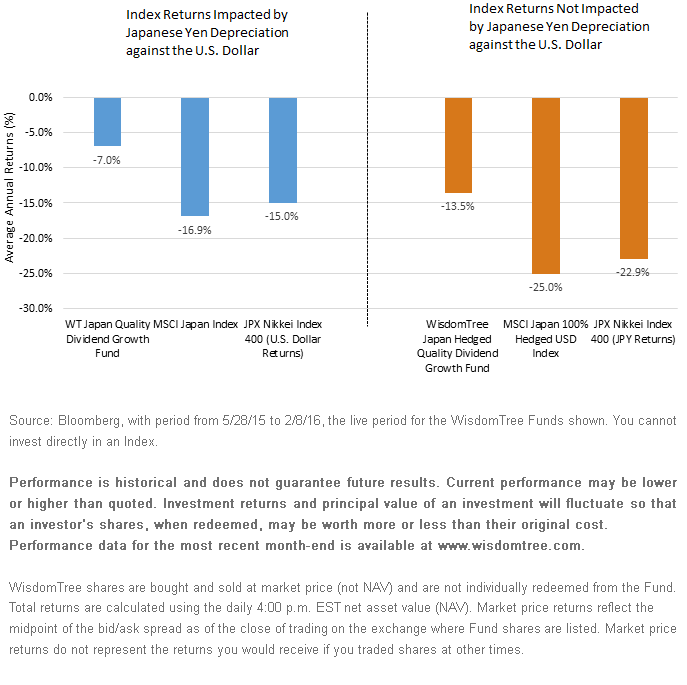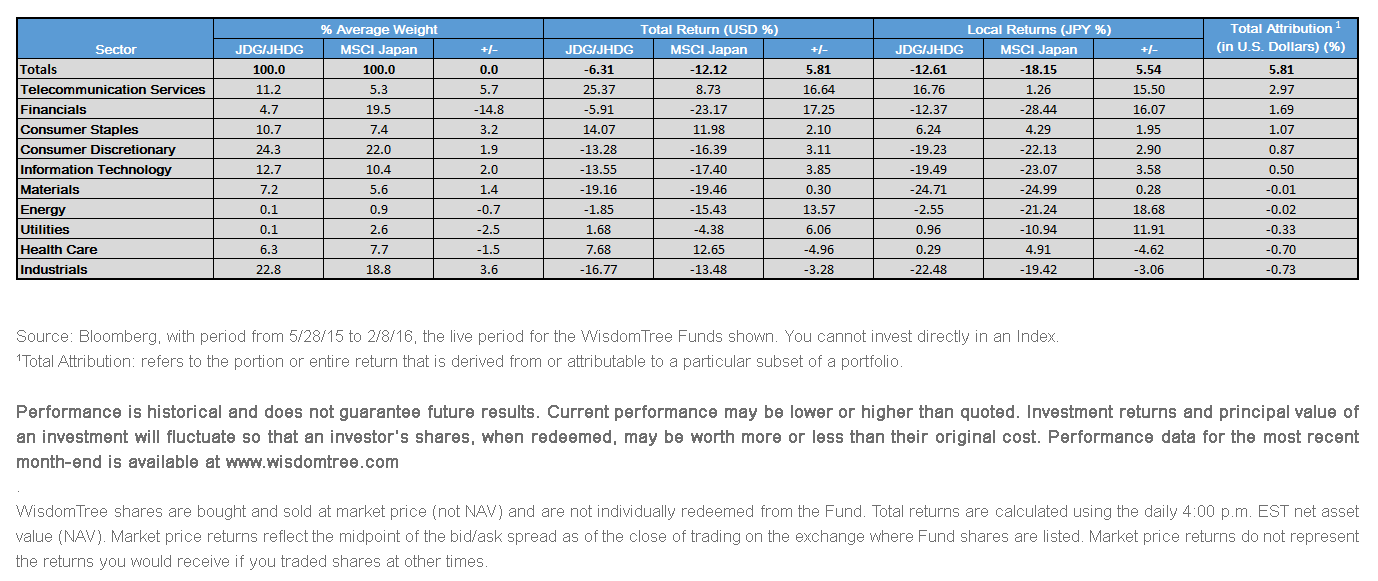On Japanese Central Bank Action, Japan Quality Factor in Focus


 Looking at a table of the sector exposures of the WisdomTree Japan Quality Dividend Growth Funds (both share the same constituents and sector exposures) and the market capitalization-weighted MSCI Japan Index, there are a few notable sector tilts worthy of discussion:4
1) The WisdomTree Japan Quality Dividend Growth Funds (both the hedged and unhedged versions) have been significantly under-weight Financials (with weights averaging less than 5% versus close to 20% in the MSCI Japan Index), due to the inclusion of ROA as a factor in the selection process. Financials tend to have high leverage and typically low return on assets, so they tend to receive less weight in WisdomTree’s Japan Quality Dividend Growth Funds. Since the launch of these Indexes, Financials has been among the weakest-performing sectors and has been dragging down the MSCI Japan Index. This has been the second biggest contribution to relative performance for the WisdomTree approach.
2) The biggest contribution to relative performance has come from a sector in which the relative weight differential is smaller, but the stock selection impact has been much greater: the Telecommunication Services sector. WisdomTree Japan Quality Dividend Growth Funds have had about a 6% average over-weight to this sector, but the average stock return from the sector was much higher than that of the MSCI Japan Index.
3) The biggest drag in performance for the WisdomTree Japan Quality Dividend Growth Funds has been the 3.6% over-weight and selection in the Industrials sector. This also has been a weak-performing sector, but the value added from other sectors more than made up for this sector’s drag in performance.
Attribution: WisdomTree Japan Quality Dividend Growth Funds (JDG & JHDG)
Looking at a table of the sector exposures of the WisdomTree Japan Quality Dividend Growth Funds (both share the same constituents and sector exposures) and the market capitalization-weighted MSCI Japan Index, there are a few notable sector tilts worthy of discussion:4
1) The WisdomTree Japan Quality Dividend Growth Funds (both the hedged and unhedged versions) have been significantly under-weight Financials (with weights averaging less than 5% versus close to 20% in the MSCI Japan Index), due to the inclusion of ROA as a factor in the selection process. Financials tend to have high leverage and typically low return on assets, so they tend to receive less weight in WisdomTree’s Japan Quality Dividend Growth Funds. Since the launch of these Indexes, Financials has been among the weakest-performing sectors and has been dragging down the MSCI Japan Index. This has been the second biggest contribution to relative performance for the WisdomTree approach.
2) The biggest contribution to relative performance has come from a sector in which the relative weight differential is smaller, but the stock selection impact has been much greater: the Telecommunication Services sector. WisdomTree Japan Quality Dividend Growth Funds have had about a 6% average over-weight to this sector, but the average stock return from the sector was much higher than that of the MSCI Japan Index.
3) The biggest drag in performance for the WisdomTree Japan Quality Dividend Growth Funds has been the 3.6% over-weight and selection in the Industrials sector. This also has been a weak-performing sector, but the value added from other sectors more than made up for this sector’s drag in performance.
Attribution: WisdomTree Japan Quality Dividend Growth Funds (JDG & JHDG)
 For investors looking to add exposure to Japan, WisdomTree has been known for its currency-hedged approach to exporter companies in its primary Japan ETF, the WisdomTree Japan Hedged Equity Fund (DXJ). But this is not the only broad-based way to allocate to Japan that WisdomTree offers.
Whether it is an unhedged ETF for those who believe the yen may rise, or a Fund for those who do not want currency exposure in a hedged ETF, both of our Japan Quality Dividend Growth ETFs (JDG for unhedged and JHDG for hedged) represent important exposure that we believe compares favorably to traditional Japanese benchmarks.
1Source: Bloomberg, with levels of the yen versus the U.S. dollar studied from 4/13 (initiation of qualitative and quantitative monetary easing) to 2/16/16.
2The WisdomTree Japan Hedged Quality Dividend Growth Fund (JHDG) was designed to track the returns, before expenses, of the WisdomTree Japan Hedged Quality Dividend Growth Index. The WisdomTree Japan Quality Dividend Growth Fund (JDG) was designed to track the returns, before expenses, of the WisdomTree Japan Quality Dividend Growth Index.
3Sources: WisdomTree, Bloomberg, as of 2/5/16, based on ROE, ROA and long-term earnings growth estimates.
4Source for numbered paragraphs: Bloomberg, with data from 3/3/14 to 2/5/16.
For investors looking to add exposure to Japan, WisdomTree has been known for its currency-hedged approach to exporter companies in its primary Japan ETF, the WisdomTree Japan Hedged Equity Fund (DXJ). But this is not the only broad-based way to allocate to Japan that WisdomTree offers.
Whether it is an unhedged ETF for those who believe the yen may rise, or a Fund for those who do not want currency exposure in a hedged ETF, both of our Japan Quality Dividend Growth ETFs (JDG for unhedged and JHDG for hedged) represent important exposure that we believe compares favorably to traditional Japanese benchmarks.
1Source: Bloomberg, with levels of the yen versus the U.S. dollar studied from 4/13 (initiation of qualitative and quantitative monetary easing) to 2/16/16.
2The WisdomTree Japan Hedged Quality Dividend Growth Fund (JHDG) was designed to track the returns, before expenses, of the WisdomTree Japan Hedged Quality Dividend Growth Index. The WisdomTree Japan Quality Dividend Growth Fund (JDG) was designed to track the returns, before expenses, of the WisdomTree Japan Quality Dividend Growth Index.
3Sources: WisdomTree, Bloomberg, as of 2/5/16, based on ROE, ROA and long-term earnings growth estimates.
4Source for numbered paragraphs: Bloomberg, with data from 3/3/14 to 2/5/16. Important Risks Related to this Article
There are risks associated with investing, including possible loss of principal. Foreign investing involves special risks, such as risk of loss from currency fluctuation or political or economic uncertainty. Funds focusing their investments on certain sectors may be more vulnerable to any single economic, regulatory or sector-specific development. This may result in greater share price volatility.
The Funds focus their investments in Japan, which can be impacted by the events and developments in Japan that can adversely affect performance. Dividends are not guaranteed, and a company currently paying dividends may cease paying dividends at any time. As these Funds can have a high concentration in some issuers, the Funds can be adversely impacted by changes affecting those issuers. The Funds invest in the securities included in, or representative of, their Indexes regardless of their investment merit, and the Funds do not attempt to outperform their Indexes or take defensive positions in declining markets.
The currency-hedged Funds use various strategies to attempt to minimize the impact of changes in the Japanese yen against the U.S. dollar, which may not be successful. Derivative investments can be volatile, and these investments may be less liquid than other securities, and more sensitive to the effects of varied economic conditions. Due to the investment strategy of these Funds, they may make higher capital gain distributions than other ETFs. Please read each Fund’s prospectus for specific details regarding each Fund’s risk profile.

Jeremy Schwartz has served as our Global Chief Investment Officer since November 2021 and leads WisdomTree’s investment strategy team in the construction of WisdomTree’s equity Indexes, quantitative active strategies and multi-asset Model Portfolios. Jeremy joined WisdomTree in May 2005 as a Senior Analyst, adding Deputy Director of Research to his responsibilities in February 2007. He served as Director of Research from October 2008 to October 2018 and as Global Head of Research from November 2018 to November 2021. Before joining WisdomTree, he was a head research assistant for Professor Jeremy Siegel and, in 2022, became his co-author on the sixth edition of the book Stocks for the Long Run. Jeremy is also co-author of the Financial Analysts Journal paper “What Happened to the Original Stocks in the S&P 500?” He received his B.S. in economics from The Wharton School of the University of Pennsylvania and hosts the Wharton Business Radio program Behind the Markets on SiriusXM 132. Jeremy is a member of the CFA Society of Philadelphia.

